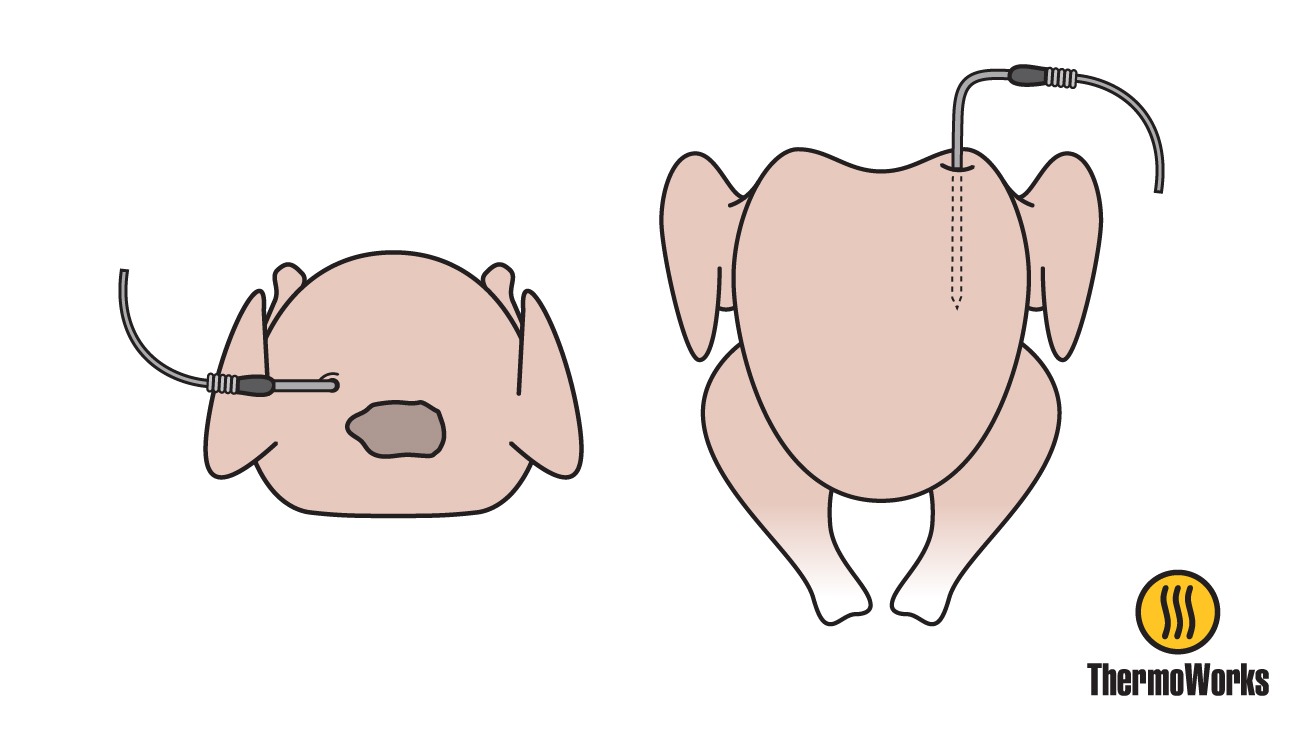Thanksgiving is one of the most food-centered days of the year, and just about the only time for a Turkey to shine. In this post, we’ll help you with one of the key principles of turkey cooking that you need to get a perfect bird this year!
While you can find any number of turkey recipes with varying methods and flavors they all have one thing in common: making sure your turkey is properly cooked. And the thermal principles that we talk about here for cooking your turkey are applicable to any recipe.
Cooking the perfect juicy and delicious turkey breast that is safely cooked to the proper temperature is a delicate culinary balancing act. Knowing exactly where to place the thermometer is crucial to turkey breast success. This comprehensive guide provides everything you need to know about thermometer placement for foolproof turkey breast every time.
Why Thermometer Placement Matters
Precise thermometer placement is key for several reasons
-
It ensures an accurate reading of the turkey’s internal temperature so you know it has reached the minimum safe temperature of 165°F to destroy any potential foodborne illnesses
-
It prevents overcooking so your turkey stays tender and juicy rather than drying out.
-
It allows you to cook the breast to your desired level of doneness whether you prefer it at 160°F for pink meat or 165°F for well done.
Choosing Your Thermometer
To get an accurate temperature reading in the turkey breast, the type of thermometer you use matters. Here are the best options:
-
Leave-in probe thermometers that remain in the meat during cooking are ideal for tracking the temperature over time. Models like the ChefAlarm thermometer allow you to monitor the temp without repeatedly opening the oven.
-
Instant-read thermometers like the Thermapen provide quick readings to check temperature at a specific moment. Use them to verify final temperature after cooking.
-
Standard oven-proof thermometers are budget-friendly options that get the job done. Place in the breast at the start of cooking.
Digital thermometers tend to be more accurate than dial versions.
Picking the Right Thermometer Spot
Choosing where to insert the thermometer probe is critical for precision. Follow these placement tips:
-
Insert the probe into the thickest part of the breast, going in horizontally from the side.
-
Make sure to avoid bone, since it conducts heat differently than the meat.
-
For a whole turkey, enter near the neck and aim toward the thickest area of the breast.
-
Place the probe tip about 1⁄2 – 1 inch from the inner cavity without touching it.
-
The tip should be surrounded by meat both above and below for an accurate center-of-breast reading.
Step-By-Step Thermometer Use
Follow this process for perfect thermometer placement:
-
If using a leave-in probe, insert it into the center of the thickest area before cooking. For an instant-read, wait until turkey is finished cooking.
-
Carefully push the probe in horizontally from the side, 1⁄2 – 1 inch from the inner cavity. Stop when the tip hits the thermal center.
-
Avoid bones, fat, gristle and the pan so you only measure meat temperature.
-
For instant reads, allow 15-20 seconds for the temperature to stabilize before reading.
-
Verify final temp reaches 165°F. If under, continue cooking and recheck until it hits 165.
-
Check multiple spots to confirm even cooking. Breast, thigh and wing areas may vary.
Handy Thermometer Techniques
-
Calibrate your thermometer regularly for accuracy. An ice water bath checks its precision.
-
Sanitize before using. After reading internal temp, disinfect to avoid cross-contamination.
-
Use thermometer prompts as a guide, but also rely on visual cues like browned skin.
-
Let meat rest 3-5 minutes before carving to allow juices to redistribute.
Avoiding Pitfalls
Steer clear of these thermometer mistakes:
-
Placing too shallow – Probe must reach thermal center of thickest area.
-
Touching bone – Causes false high readings since bone conducts heat differently.
-
Piercing all the way through – Tip should not hit cavity area to prevent false low temps.
-
Assuming one spot is representative – Check multiple locations for even thorough cooking.
-
Failing to calibrate – Accuracy declines over time so verify regularly.
Achieving Turkey Perfection
Armed with this guide to thermometer placement in turkey breast, you have an expert-level path to succulent, flavorful meat cooked to the ideal temperature. Monitor that breast temp precisely using a high-quality thermometer placed properly in the thickest spot, and you’ll serve up the best turkey ever. With the thermometer as your helper, tossing the turkey breast in the oven turns from guessing game into foolproof science. Gobble gobble!

The First Step: Accurate Probe Placement
For best results, insert your thermometer’s oven-safe probe ( a DOT® with a Pro-Series® probe) into the deepest part of the turkey breast, avoiding bone. You want an even layer of meat above and below the probe so that it’s evenly surrounded by the meat.
Avoiding bones is important because bone has different thermal properties than meat. A probe resting against a bone will not give an accurate temperature reading for the meat itself. Plus the bones are not in the thermal center of the bird.

To Place your Probe Correctly, Understand 3 Things:
Heat moves. Sounds obvious right? Maybe not. Because of the way that heat is transferred through substances, the outside of a turkey will be at a higher temperature than the inside. This difference in temperature between the exterior and interior of the meat is called a temperature gradient.
Understanding temperature gradients leads to understanding proper probe placement: the thermal center.
How to Insert a Meat Thermometer into Turkey
FAQ
Where is the best place to check the temperature of a turkey breast?
Where to put leave in thermometer in turkey?
Is turkey done at 165 or 180?
What is the proper temperature for turkey breast?
